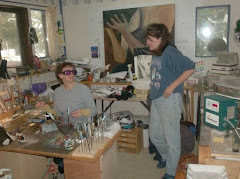
 Well it took a lot longer than I expected (doesn't it always) but I think I have the basics of card weaving figured out. I got lots of help from fellow weavers on Ravelry. That was great!
Well it took a lot longer than I expected (doesn't it always) but I think I have the basics of card weaving figured out. I got lots of help from fellow weavers on Ravelry. That was great!
What it took to get me going was finding a method of working that allowed me to know where I was in the pattern at all times and what I had to do next. That meant amalgamating all the methods I had read about into one that worked for me. Since I had found lots videos that showed looms, or people making cards and actually weaving I just needed to know how to move the cards. Did I say 'just'? Those are the details that make all the difference, aren't they?
Knowing what card to turn when and what direction to turn it was the missing detail. Here are a few things I that helped me conquer the details.
The first thing I did was dispense with the traditional 'A' and 'B' method of describing the position of threads on each card. I made my own cards from an old poker deck and simply drew a line on both sides of the cards between two of the holes. That would indicate where similar color threads were and, more importantly, my starting and ending position for weaving. (Linda Hendrickson advises this. Watch her video on continuous warp. She does amazing weaving!)
I also made a handy 'pin' to lock the cards in position when I was away from the loom or needed to move the warp. It's part of a coat hanger. All it took was a pair of needle nose pliers and the overwhelming desire to keep the cards in place when I was frustrated and needed to take a break.
Here are a few things I found while the weaving is underway that made it easier for me to get good results:
1. Always know where the shuttle is supposed to be when a row of the pattern is completed. Is it on the left or the right of the warp? That way, if you now if you're just starting a row, in the middle of one, or just finished. (Call the finished position the 'resting' position.)
2. Before you start weaving mark your pattern as to what direction the background pack of the row is to turn. Isolate each row in your view while you work it so you don't get confused as to where you are in the pattern. (More on that later)
3. Be consistent as to where you slide the cards when you separate them for turning in your design. For instance, always put the cards for the background nearest you on the warp and those the make up the pattern further way from you. I chose not to work separate selvages just yet.
4. Once the cards are separated into background and pattern packs consult the row isolated on the pattern and turn each pack the right way. Put the shuttle through, then turn the cards again in the same direction to complete the row. Put the shuttle through the final time to it's resting position. Then move the row indicator on your pattern.
5. Reassemble the cards into one group and check to see that the lines are all the the same place. By having a line on the cards I could quickly shuffle through to see if I've left a card behind when I was turning or if I turned any the wrong way.


No comments:
Post a Comment